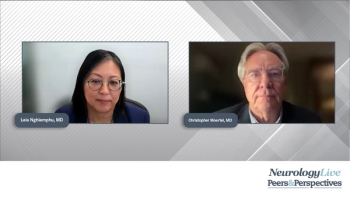
NeuroVoices: Brian Lin, PhD, on Targeted Therapies and Biomarkers to Drive New Momentum in ALS Research

The research portfolio director at the Muscular Dystrophy Association highlighted advances in gene-targeted therapies and biomarker development as potential key drivers of progress in ALS.
Despite extensive research, amyotrophic lateral sclerosis (ALS) remains a progressive and fatal neurodegenerative disease with limited therapeutic options for patients living with the condition. One of the major challenges for the ALS field has been the incomplete understanding of the disease’s underlying biology, which has restricted the ability to target upstream mechanisms. Studies have also shown that while most ALS treatments are initiated late in the disease course, genetic forms of the disease present a potentially unique opportunity for earlier and more targeted care interventions.1
Tofersen (Qalsody; Biogen) is an
In a new iteration of
NeurologyLive: What areas of ALS research are showing the most promise right now?
Brian Lin, PhD: Right now, I would say the most promising areas in ALS research are probably the gene-targeted and RNA-targeted therapies, and also biomarker discovery. ASOs are really the standouts in the ALS field right now, with tofersen which was approved in 2023. We’re just starting to see some of the real-world data come out about tofersen and how it has really benefited patients with ALS who have that specific gene mutation in the SOD1 gene.
In these patients, there are some studies that have come out, especially one by Timothy Miller, MD, PhD, codirector at the MDA/ALS Care Center at Washington University in St. Louis. and his group, that have shown real-world data that tofersen is not only slowing disease progression in some patients, but it’s stabilizing their condition and leading to, also in some patients, some functional improvements as well. They’re getting stronger in a few ways.
For the ALS community, this is really exciting because for the first time, it’s showing that, at least for the genetic forms of ALS, this disease is treatable. I think everyone in the field is really looking forward to seeing if some of the other genetically targeted therapies that are in the pipeline are going to be as successful as tofersen. We should really see those results coming out pretty soon.
Along with that, I think biomarkers are one of the areas that have seen significant growth in research over the last few years. Biomarkers are critical because they help us evaluate how well a treatment works, and they also allow us to diagnose the disease a lot faster. Overall, that’s huge for ALS.
We now have a biomarker called neurofilaments, which can help us track how the disease is progressing in real time. This is a marker of neuronal damage, and we can see this marker in the biofluids of patients, like their blood and cerebrospinal fluid. Now, it’s used throughout ALS clinical trials to really track how patients are doing.
There are also other types of biomarkers that are advancing like neuroimaging markers and those derived from digital health technologies, such as wearable devices. These could potentially revolutionize how we track disease progression in ALS clinical trials, especially for a patient population that can’t make it to the clinic at all times. So, this is a great shift toward personalized, mechanism-based ALS therapeutics in the overall research field.
What upcoming studies or therapies in the pipeline are you most excited about?
Some of the most exciting therapeutics are happening at the genetic and molecular levels as well. I talked a little bit about tofersen and the ASOs, but one study that’s currently underway is the ATLAS study. This is also looking at tofersen —it’s a confirmatory phase 3 study, so separate from what was already done—and it’s really designed to assess how starting tofersen in presymptomatic individuals, so people who haven’t clinically manifested ALS, can affect them. This study is particularly exciting because it’ll tell us a lot about not only whether we can treat disease, but if we’re able to delay or even prevent ALS from happening in those patients who are genetically predisposed.
We’re also seeing a lot of momentum in the cell and gene therapy space as well for ALS. For example, therapies using CRISPR-based tools are being developed to knock down pathogenic genes. Those are rapidly moving forward in the preclinical stage. They haven’t fully reached the clinical stage yet for ALS, but we do have companies like QurAlis, who are running gene therapy trials with their candidates for SOD1. I think they’re in phase 1 or phase 2 right now.
At the MDA, we’ve seen gene therapy advance for a number of our diseases like Duchenne muscular dystrophy, for example, and it’s great to see that ALS is starting to enter the picture for the gene therapy landscape. Ultimately, even if these therapeutics are successful or unsuccessful, these trials will really reveal a lot about the underlying biology of the disease. Now more than ever, we are positioned as a field to really take advantage of the tools that we have with these studies, and how we’re collecting patient biofluid samples to really leverage this information toward creating the next generation of therapeutics. The more targeted therapeutics, for example.
How is MDA helping to accelerate breakthroughs in ALS research and patient care?
At the MDA, I’ve been part of leading some of those research efforts and have really seen firsthand how committed our organization is to changing the narrative, the story, and the legacy impact of momentum around ALS. This is a disease that has had very limited treatment options like riluzole and edaravone for so long, and now there’s tofersen, which is an effective therapy for a small portion of the ALS population.
Just this past March, MDA celebrated our 75th anniversary at our annual clinical and scientific conference. When we look back at our history, over the past 75 years, we’ve invested over $178 million toward ALS research. A lot of the breakthroughs we’re seeing today, like gene therapies and RNA-targeted therapeutics, are all because of research that was funded decades ago. That’s where it all started.
What really makes our work and our initiative so powerful is that we don’t just focus on one initiative or one particular area. We’re driving progress by funding various initiatives on ALS including in research, in patient care, and in some of our advocacy initiatives as well.
In terms of research, which I’m most involved with, our philosophy has always been to invest in bold, early-stage research that some may see as risky or maybe too risky to fund. On the other end of the spectrum, we also fund what may seem like very basic research, but these are essential studies that need to be performed to advance the field.
We also place a deep emphasis on our young investigators, our development grantees, because we really need these young postdoctoral fellows who are making their way in their careers and trying to become independent investigators, to be part of the field and to push it forward. They’ll be the next generation to run new clinical trials in the future, especially as the current pioneers in the field begin to retire over the next decade or two.
Beyond research, MDA is a big part of care. We operate the nation’s largest network of multidisciplinary care clinics, including 47 certified centers for ALS. Through our network, we’re helping people with ALS get access to multidisciplinary care, to genetic testing, to the latest clinical trials. All of these are critical for individuals with ALS so they can live longer, more independent lives and not only navigate the physical stresses of the disease, but also the emotional and mental challenges that ALS presents.
Transcript edited for clarity.
REFERENCES
1. Benatar M, Wuu J, Andersen PM, et al. Design of a Randomized, Placebo-Controlled, Phase 3 Trial of Tofersen Initiated in Clinically Presymptomatic SOD1 Variant Carriers: the ATLAS Study. Neurotherapeutics. 2022;19(4):1248-1258. doi:10.1007/s13311-022-01237-4
2. FDA approves treatment of amyotrophic lateral sclerosis associated with a mutation in the SOD1 gene. News release. FDA. April 25, 2023. Accessed May 6, 2025. https://www.fda.gov/drugs/news-events-human-drugs/fda-approves-treatment-amyotrophic-lateral-sclerosis-associated-mutation-sod1-gene
Newsletter
Keep your finger on the pulse of neurology—subscribe to NeurologyLive for expert interviews, new data, and breakthrough treatment updates.



















